Takashi Oda is famous in Japan for his practical effects work on various horror films, including the classic Tetsuo II: BODY HAMMER, but before he went into film-making full time, he briefly worked at Namco. He came along at just the right time, as when he was hired, there was a horror arcade game in the works. Of course, we all know what that was.
Presented here is an interview I had the pleasure of conducting with Oda-san during September and October 2022, about his time at Namco, his work on Splatterhouse, and his early days in film. You may find some long-standing questions about the original game answered as you go through it. Enjoy!
This is the complete interview. Editing was for grammatical purposes only.
***
Rob: How did you get your start at Namco, and what was the first game you worked on?
Takashi Oda: After graduating from high school in Hiroshima, I studied special makeup effects while working at a coffee shop in Shibuya, Tokyo. When I was looking for a more creative job, I read a recruiting magazine and saw an advertisement with a picture of Pac-Man and the logo of Namco. Hiroshi Ono, who drew pixel art such as Galaga, Mappy, and Xevious, was the interviewer. He was so amused by the monsters I drew that I ended up working part-time at Namco. Since there weren't many people who could draw horror elements, I decided to draw a Splatterhouse character as a newcomer. It was a miraculous timing.
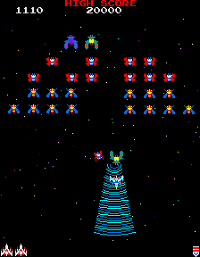
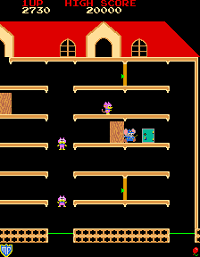
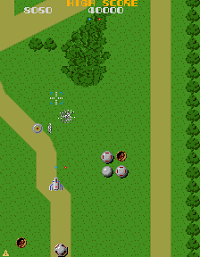
L to R: Galaga, Mappy and Xevious
Rob: How did the whole idea of making Splatterhouse happen? Did it come about because of the character you'd drawn, or were the plans for a horror game in the works already?
Takashi Oda: Planning had already started, and there was only a zombie template. At that time, there were many creators at Namco who were good at cute designs, so it seems that I was the right person because I was learning special makeup effects.
Rob: So how did the Splatterhouse project come about, in the first place?
Takashi Oda: Splatterhouse started before I joined Namco, so this is speculation. Demons, Day of the Dead, House, The Return of the Living Dead, Evil Dead II, etc. were released, and it was also said to be a horror movie boom. I think that this project was created by the producer KAZUU (Mr. KAZUMI MIZUNO) because of that influence. He was also in charge of the graphics for Pac-Land, and has also worked on projects such as Dig Dug II and Yokai Dochuki.
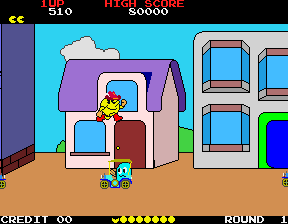
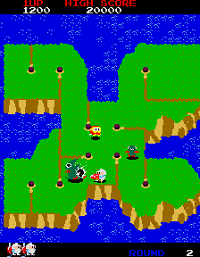
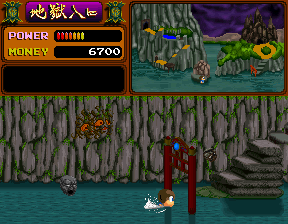
L to R: Pac-Land, Dig Dug II and Yokai Dochuki
Rob: You're listed in the credits for the game as "Special Visual Effects." Did you have a hand in designing all of the characters, and did you contribute to the design of West Mansion as well?
Takashi Oda: (I designed) Rick Taylor, Hanging Dead/Hanging Corpse, Water Dead, Evil Dog/Undead dog, Water Hand/Water Zombie, Knoboo/Nobu, Mirror Rick, Woody/Uddei, Egg Ova, Ova, Body Eater, Piggyman/Biggyman, Mother (and) Hell Chaos. (I also created the) Skewered zombies, fettered zombies, and chained zombies in the background, (as well as) Lumber, Axe, Machete, Spanner, Stone, Shotgun, Harpoon, Wineglass, Candle, Spirit. Other characters such as Jennifer and Deadman are drawn by different creator. The West Mansion was drawn by the background designer.
Rob: This may seem like a very obvious question, but was Rick's design influenced by the look of Jason Voorhees from the Friday the 13th movies?
Takashi Oda: Yes, I was instructed to draw a brawny man in a hockey mask. Therefore, I thought it was a Voorhees game and drew it. Because I misunderstood that it was a project that had not been revealed to me, a newcomer. One morning I was told that it was not good to look too much like Voorhees. That's when I knew it wasn't licensed. I erased the red pattern on the mask and made the curvature stronger. But the save name of the file was JSON until the end. The file name was JSON because there was a four character limit.
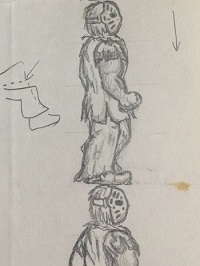
Oda-san's original Rick artwork. (click to enlarge)
Rob: Many people have wondered over the years why Rick doesn't wear shoes. Was there any specific reason?
Takashi Oda: The reason why Rick's feet don't have shoes is that wearing shoes would reduce the number of skin tones available. As for the shape of the shoes, I drew the feet in the same color as the skin, so it looked barefoot to Mr. Komoriya. However, the barefoot Rick was powerful and cool, so I was convinced. Barefoot Rick was born out of a nice misunderstanding and a lack of shoe colors due to skin gradation.
Rob: Were there any creatures that you wanted to include that were cut for time/space reasons?
Takashi Oda: No characters were cut, but Rick's walking pattern was reduced from eight to four. There were two buttons + a jump button for attacks, and there were punches and kicks on the top and bottom, but to simplify the operability, the top is a punch and the bottom is a kick.
Rob: What horror films were an influence on your character designs?
Takashi Oda: The Thing, Evil Dead and Alien.
Rob: Which characters that you designed are you particularly proud of? So many of them have become favorites among the Splatterhouse fanbase.
Takashi Oda: Hell Chaos (and) Nobu. I like the effect of the Hanging Dead's guts dropping and the Water Dead's splashing effect.
Rob: What exactly does Master Dead say when he raises the dead?
Takashi Oda: Master Dead says, "anokorowa, ha!" It's a spell. Itís a word that sounds like ďAt that time, ha!Ē It seems to be a directorís idea with no deep meaning. Itís a word we use when we think about the past. You may be able to take it as meaning that you want to go back to those days.
Rob: I've seen your 2022 Biggy Man statue, which is a thing of horrific beauty. As I'm sure you know, Biggy Man is one of the most popular characters from the game. However, what's the origin of the name "Piggy Man"?
Takashi Oda: The name was inspired by the Halloween boogeyman. It's the director's idea. I borrowed the name Rick from Rick Baker, a special makeup artist I admire.
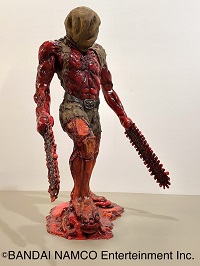
Oda-san's Biggy Man statue for Wonder Festival 2022. (click to enlarge)
Rob: So it actually was Biggy Man from the start? Not Piggy Man?
Takashi Oda: He was a Piggyman from the beginning. I think Biggy Man is a name that considers the overseas market. Maybe it's because they're not like pigs.
Rob: Also, did you see the redesigned Biggy Man for the 2010 Splatterhouse, and if so, what did you think of that interpretation of the character?
Takashi Oda: I haven't played with the 2010 one. Overall, the production is flashy and looks different from the world view of Splatterhouse, which gives an impression similar to Splatterhouse 3. Splatterhouse's Rick was muscular and strong, but not a monster. It must be the judgment of the planner for new hardware and new players. I think they wanted to make a difference for Biggy Man as well.
Rob: You may be right about that. There were three designs for Biggy Man: one which was nothing like the original, one that was very close to the original, and the final, which was like a mix of both.
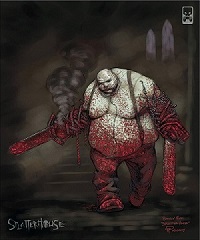
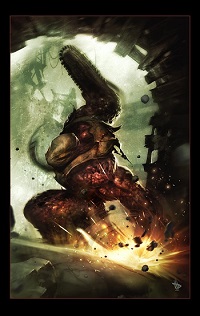
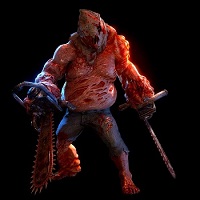
L to R: first concept by Roger Robinson, second concept by Dave Wilkins, final design. (click to enlarge)
Personally, I like the second one the best.
Takashi Oda: I also like the second one best. Because the Piggyman doesn't need eyes. It is characteristic of him that he does not know what he is thinking, where he is looking, or even what he sees.
Rob: I agree completely. That was always part of his mystery. What was under the bag? We'll never know.
Takashi Oda: Who does his face look like? Are there eyes in the bag? Even I, who created it, do not know it.
Rob: Then there's Mother. A lot of fans believe that West Mansion itself is alive, Mother is the heart of West Mansion, and when it's destroyed, that's why the Mansion burns down. Is there any truth to that?
Takashi Oda: That's a very interesting interpretation! At the time of development, we were not told why the West Mansion burned down. It may have been spontaneous and may have been Mother's will.

Mother (stage six boss)
Rob: Really? That's something I'd never thought of. Which leads me to ask: what exactly is Hell Chaos? Maybe more importantly, what's the "ghost face" that rises out of the ground after it's destroyed? Is it the spirit of Dr. West, as a lot of fans believe it to be?
Takashi Oda: Hell Chaos is the spirit that resided in the Hell Mask and joined with something in the ground, and that cross is thought to have been Dr. West. The goal would have been to destroy the terrifying mansion created by Dr. West and free his own soul.
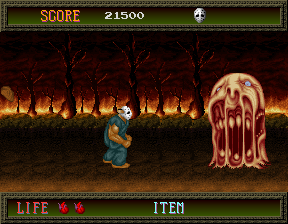
Hell Chaos (final boss)
Rob: How successful was Splatterhouse in Japan? Here in the United States, it was very rare to find a Splatterhouse cabinet. Some claim the game had been banned, due to excessive violence and gore. It wasn't until the Turbografx-16 port was released that Splatterhouse became well known here.
Takashi Oda: Splatterhouse seems to have been well received in Japan. Many people say they are enthusiastic. Human-shaped zombies were abolished and Deadman was drawn as a monster because it was necessary to avoid cruel depictions. The blood color has also been changed to green. The organs of the hanging dead were also red.
Rob: Do you know what reaction the Splatterhouse staff had to the supposed controversy over the game here in the USA?
Takashi Oda: I didn't even know there was a controversy. I don't know what kind of reaction it was in Bandai Namco.
Rob: Having seen the few sketches that you released to the public, I have to ask: do you have anything else from the development of Splatterhouse that has never been seen by the public that you would be willing to share?
Takashi Oda: No sketches left. Many of the creatures were drawn on the computer without detailed sketches.
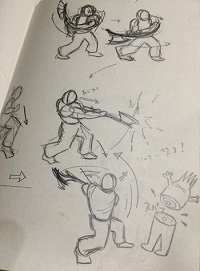
One of the only surviving pieces of concept art. (click to enlarge)
Rob: That's sad to hear. Do you have any interesting stories about anything that happened during development?
Takashi Oda: When I was drawing Hell Chaos, my right hand went numb and I went to the hospital. The doctor said that my hand was about to become unusable, but no specific reason was given. My arm healed when I finished drawing Hell Chaos' arm while taking medicine.
Rob: So drawing Hell Chaos almost put your arm out of commission, but finishing him fixed it up. Along with the medicine, of course.
Takashi Oda: Defeating Hell Chaos may be good for arm health!
Rob: Rick didn't get all of those muscles for no reason! You're also listed in the credits of the PC Engine port as "Visual Effect." How involved with the port were you?
Takashi Oda: I'm not involved in the PC Engine, but I think it was credited because the object data was taken over almost as it was.
Rob: Did you have any input on any of the sequels or Splatterhouse: Wanpaku Graffiti?
Takashi Oda: I didn't know about a sequel because I was working on visuals separate from game development. Wanpaku Graffiti is the Famicom version, so it makes sense that cruel expressions were avoided. The other sequels have disappointing alien-like designs and flashy colors, but I think this is due to the lack of color gradation in GENESIS.
Rob: Do you keep in touch with anyone from Splatterhouse's development?
Takashi Oda: I haven't seen another developer in a long time. I meet Yuichiro Komoriya, who drew the illustration for the instruction card, once a year.
Rob: How long were you with Namco, in the end?
Takashi Oda: I think I was at Namco for less than a year. I left in order to get closer to my original dream, film work. Did I do something a little disappointing?
Rob: I certainly don't think so. You have to follow your dreams to achieve success! I'd read about some of your film work, especially Tetsuo II. What was the first film you worked on after leaving Namco?
Takashi Oda: The first movie I participated in was ZIPANG, and the first movie I received as my own work was Tetsuo 2 BODY HAMMER. After that, I was in charge of Hiruko the Goblin, but Hiruko the Goblin was completed and released first.
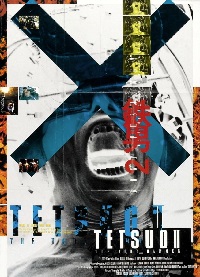
Theatrical poster for Tetsuo 2 BODY HAMMER (1992). (click to enlarge)
Rob: You've done effect work and creature design on many films. Besides Rick Baker, who have been some of the biggest inspirations for your work?
Takashi Oda: H. R. Giger, Rob Bottin and Steve Wang.
Rob: As an effects artist, do you prefer working with practical effects, or working with computers?
Takashi Oda: I like effects that use real objects.
Rob: Did you ever work on another video game after Splatterhouse, or have you only worked in film since?
Takashi Oda: Around 2000, Namco requested several designs, but they were not adopted. I haven't done any other design. I have made special makeup and costumes for in-game movies. Made a sword (for this).
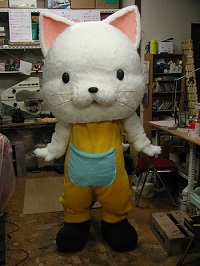
(I also created) a character that appeared in some game, but I don't know immediately (what game) because there is no data. (click picture to enlarge)
Rob: According to Kurt Kalata of Hardcore Gaming 101, that character was named Tama and is one of the main characters in the game 428: Shibuya Scramble, a visual novel.
Takashi Oda: Great, you found it!
Rob: Out of the films you've worked on, can you tell us which one you're most satisfied with?
Takashi Oda: My favorite is Hiruko The Goblin.
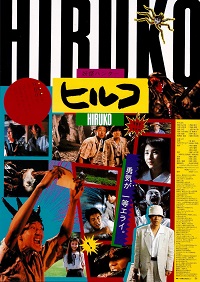
Theatrical poster for Hiruko The Goblin (1991). (click to enlarge)
Rob: What would you say is the most difficult film that you've worked on, and what were the challenges you had to overcome?
Takashi Oda: Hiruko the Goblin was also difficult. I was young and didn't know the conventions of the film industry. I was full of motivation. The staff, who were suspicious of me at first, gradually became cooperative, and an interesting scene was born.
Rob: How much interaction did you have with Mr. Tsukamoto while you worked with him?
Takashi Oda: I did about ten works up to Nightmare Detective 2. We still keep in touch with each other through sofubi supervision and anniversary screenings.
Rob: There is a list of the films you've worked on, on the website IMDB. However, it only shows your films up through 2010. Have you worked on any since, and if so, what films are those?
Takashi Oda: Since 2010, I have mainly worked on dramas, commercials, and sculptures in museums, but no horror works. Of course I am active.
Rob: You personally sculpted the Hell Chaos that was sold by Unbox Industries, if I recall correctly. How did it feel to come back to work on Splatterhouse again with Unbox Industries, since so many years have passed since the game was released?
Takashi Oda: I was very happy and interested in working for Unbox, so I said hello. They immediately sent me a proposal for collaboration. Prompt decision of course! I have three Splatterhouse projects that are yet to be released.
Rob: I can't wait to see what those three projects are! But until then, is there anything else you'd like to add?
Takashi Oda: I am proud that there are fans who support us even in this era. I wish I could tell my younger self that your work will be successful. It was a very good interview, and it was also a reflection of myself. There are no detailed interviews in Japan, so it's the first time in the world!
***
Many thanks to Oda-san for taking the time out of his busy schedule to answer these questions. I wish him nothing but success in his future endeavors.
Oda-san's homepage
Oda-san's Twitter
Oda-san's Instagram
This exclusive interview is copyright 2022 SCAR Productions.